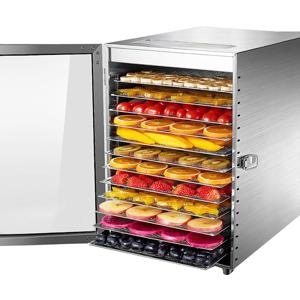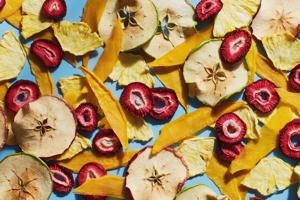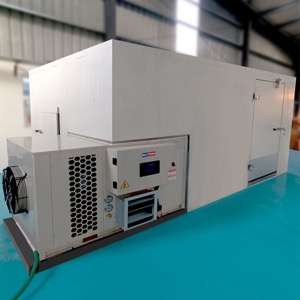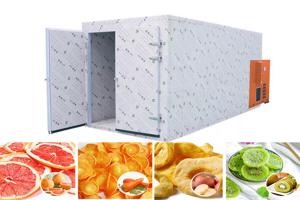
Content Menu
● What is a Food Dryer?
>> The Importance of Food Drying
● Types of Food Dryers
>> 1. Heat Pump Dryer
>> Advantages of Heat Pump Dryers
>> Disadvantages of Heat Pump Dryers
>> 2. Condenser Dryer
● Advantages of Condenser Dryers
>> Disadvantages of Condenser Dryers
>> 3. Vented Dryer
>> Advantages of Vented Dryers
>> Disadvantages of Vented Dryers
● Performance Comparison
>> Energy Efficiency
>> Drying Speed
>> Product Quality Preservation
● Applications of Food Dryers
>> Specific Use Cases
● Choosing the Right Food Dryer
● Maintenance Considerations
>> Heat Pump Dryer Maintenance
>> Condenser Dryer Maintenance
>> Vented Dryer Maintenance
● Conclusion
● Frequently Asked Questions
>> 1. What is the main difference between heat pump dryers and condenser dryers?
>> 2. Are heat pump dryers suitable for all types of food?
>> 3. How do I maintain a vented dryer?
>> 4. What are the energy costs associated with each type of dryer?
>> 5. Can I install a condenser dryer in any location?
Food drying is an essential process in the food industry, helping to preserve food while maintaining its nutritional value and flavor. As a manufacturer of food dryers, it is crucial to understand the different types of dryers available in the market, particularly heat pump dryers, condenser dryers, and vented dryers. This article will explore these three types of food dryers in detail, comparing their performance, efficiency, and suitability for various applications.

What is a Food Dryer?
A food dryer is a device used to remove moisture from food products to inhibit the growth of bacteria, yeast, and mold. By reducing the water content, dried foods can be stored for extended periods without refrigeration. Food dryers come in various designs and technologies, each with its unique advantages and disadvantages.
The Importance of Food Drying
Food drying has been practiced for centuries as a means of preservation. The process not only extends the shelf life of food but also concentrates flavors, making dried foods popular in culinary applications. Dried fruits, herbs, vegetables, and meats are staples in many diets worldwide. Additionally, drying can reduce transportation costs due to lower weight and volume.
Types of Food Dryers
1. Heat Pump Dryer
Heat pump dryers utilize a refrigeration cycle to extract moisture from food products. They are energy-efficient and operate at lower temperatures compared to traditional drying methods.
Advantages of Heat Pump Dryers
- Energy Efficiency: Heat pump dryers consume less energy than other types due to their ability to recycle heat.
- Gentle Drying: They operate at lower temperatures, preserving the quality and nutritional value of the food.
- Versatility: Suitable for a wide range of products, including fruits, vegetables, and meats.
- Environmentally Friendly: By using less energy and operating efficiently, heat pump dryers have a smaller carbon footprint compared to other drying methods.
Disadvantages of Heat Pump Dryers
- Initial Cost: Higher upfront investment compared to other dryer types.
- Longer Drying Times: Although energy-efficient, they may take longer to dry products.
2. Condenser Dryer
Condenser dryers work by condensing moisture from the air inside the drying chamber. The moisture is collected in a tank or drained away, allowing for efficient drying without venting outside.
Advantages of Condenser Dryers
- No Ventilation Required: Ideal for locations where external venting is not possible.
- Compact Design: Generally smaller and more portable than vented dryers.
- Consistent Performance: They maintain stable drying conditions regardless of external humidity levels.

Disadvantages of Condenser Dryers
- Energy Consumption: Typically less energy-efficient than heat pump dryers.
- Humidity Control: May require additional humidity control measures in the drying area.
3. Vented Dryer
Vented dryers expel hot air and moisture outside through ductwork. This method is common in household applications but can also be used in commercial settings.
Advantages of Vented Dryers
- Faster Drying Times: The continuous flow of hot air allows for quicker drying.
- Lower Initial Cost: Generally cheaper to purchase compared to heat pump and condenser dryers.
- Simplicity of Design: Fewer components mean easier maintenance and repairs.
Disadvantages of Vented Dryers
- Energy Inefficiency: They can consume more energy due to heat loss during venting.
- Installation Requirements: Requires proper installation of ductwork for ventilation.
Performance Comparison
When comparing heat pump dryers vs. condenser dryers vs. vented dryers in terms of performance, several factors come into play:
Energy Efficiency
Heat pump dryers lead the way in energy efficiency due to their ability to recycle heat within the system. This feature significantly reduces energy consumption compared to both condenser and vented models. In contrast, vented dryers lose a significant amount of heat during operation as they expel hot air outside.
Drying Speed
Vented dryers typically offer the fastest drying times due to their direct expulsion of hot air. However, this speed comes at the cost of higher energy usage and potential loss of product quality. On the other hand, while heat pump dryers may take longer to dry products, they do so without compromising quality.
Product Quality Preservation
Heat pump dryers excel at preserving the quality of food products thanks to their lower operating temperatures. This feature is particularly beneficial for sensitive items like herbs and fruits that can lose flavor or nutrients when exposed to excessive heat. Condenser dryers offer moderate preservation capabilities but may not match the gentleness provided by heat pump technology.
Applications of Food Dryers
Food dryers are widely used across various industries:
- Agriculture: For drying fruits and vegetables before packaging.
- Meat Processing: To create jerky or dried meat products.
- Snack Foods: For producing healthy snacks like dried fruits and vegetable chips.
Specific Use Cases
1. Fruit Drying: Heat pump dryers are ideal for drying fruits like apples and apricots because they maintain flavor and color better than other methods.
2. Vegetable Dehydration: Condenser dryers can effectively dehydrate vegetables while retaining nutrients essential for health-conscious consumers.
3. Herb Preservation: For herbs such as basil or oregano, heat pump technology ensures that delicate oils remain intact during the drying process.
4. Meat Jerky Production: Vented dryers are often preferred for making jerky due to their rapid drying capabilities that inhibit bacterial growth quickly.
5. Commercial Snack Production: Many snack manufacturers utilize a combination of dryer types depending on their product line's specific requirements.
Choosing the Right Food Dryer
When selecting a food dryer for your business, consider the following factors:
- Type of Products: Determine what types of foods you will be drying; some products may require specific dryer technologies for optimal results.
- Volume Requirements: Assess how much product you need to dry at once; larger operations may benefit from high-capacity models.
- Energy Costs: Factor in long-term energy consumption when choosing between models; while initial costs matter, operational costs can significantly impact profitability over time.
- Space Availability: Consider your facility's layout; some dryer types may require more space than others for installation and operation.
Maintenance Considerations
Proper maintenance is crucial for maximizing the lifespan and efficiency of food dryers:
Heat Pump Dryer Maintenance
- Regularly clean filters to ensure optimal airflow.
- Inspect refrigerant levels periodically to maintain efficient operation.
- Schedule professional servicing annually to check components like compressors and evaporators.
Condenser Dryer Maintenance
- Empty water tanks frequently if not connected directly to drainage.
- Clean condensate pumps regularly to prevent clogs.
- Ensure vents are clear from obstructions that could affect performance.
Vented Dryer Maintenance
- Regularly check ductwork for blockages or leaks that could reduce efficiency.
- Clean lint traps after every use to prevent fire hazards.
- Inspect external vents periodically to ensure they open freely without obstruction.
Conclusion
In conclusion, understanding the differences between heat pump dryers, condenser dryers, and vented dryers is essential for making an informed decision for your food drying needs. Each type has its unique advantages and disadvantages that cater to specific requirements within the food industry. Heat pump dryers stand out for their energy efficiency and product quality preservation, while vented dryers offer speed at a lower initial cost. Ultimately, your choice will depend on your specific applications, budget constraints, operational needs, and maintenance capabilities.

Frequently Asked Questions
1. What is the main difference between heat pump dryers and condenser dryers?
Heat pump dryers recycle heat within the system for energy efficiency, while condenser dryers condense moisture from the air without requiring external ventilation.
2. Are heat pump dryers suitable for all types of food?
Yes, heat pump dryers are versatile and can effectively dry various foods such as fruits, vegetables, meats, and herbs.
3. How do I maintain a vented dryer?
Regularly check and clean the ductwork to prevent blockages and ensure efficient airflow.
4. What are the energy costs associated with each type of dryer?
Heat pump dryers are generally more energy-efficient than condenser or vented models; however, actual costs depend on usage patterns and local energy rates.
5. Can I install a condenser dryer in any location?
Yes, condenser dryers do not require external ventilation; however, ensure there is enough space for airflow around the unit for optimal performance.












